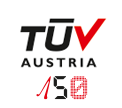Automated Driving - TÜV AUSTRIA sees to safety
- 07/07/2017
- Infrastructure & Transportation
- Created by TUEV AUSTRIA
Cars are incrementally taking over ever more tasks in automated driving. They recognize lanes, traffic signs, pedestrians and other road users. Jam assistants steer, accelerate and brake at the right moment, with the driver only acting as a monitor. Connected cars receive from the infrastructure in real time highly accurate data on maps, routes and the surroundings. This level of connectivity is required for new safety and warning functions. New vehicle system architectures with redundancies will be necessary in the near future which transfer control to the human driver in a defined manner in driving modes that are no longer controllable. The functional safety of automated vehicles is ensured by fail-operational systems. These have a host of sensors (camera, radar, light detection and ranging – LiDAR) for the redundancies required. New high-performance steering units are in the planning to manage the fusion of incoming data with its associated processing.
High requirements are naturally posed for safety-related actuators, like brakes and steering. As in all technical fields, TÜV AUSTRIA provides guidance and support for ongoing development, with analyses of scenarios and situations to enable automated and connected driving functions.
Cyber security is becoming of great importance.
There is a potential confluence of problems due to the fact that the service life of cars is longer in comparison with the shorter ones of IT products. The latter undergo multiple software updates and are exposed to constant threats of cyber-attacks. Already now, some vehicle manufacturers offer over-the-air updates (OTA) for software used in their cars. In the future, additional temporary functionalities will be enabled, like a jam assistant for vacation trips and power on demand. This creates additional business models and new user behavior. As a result, cyber security is becoming of great importance. That is to say, the ability to supply systems with updates via OTA creates new threats. For example, there is a risk of systems in vehicles and infrastructure being modified during operation for abusive or criminal purposes, necessitating a new type of testing. In addition to normal periodic inspections geared to physical components, software and cyber security will in the future also be looked at in the homologation process. Testing will therefore have to be carried out continuously during ongoing operation. This is to ensure that, in addition to individual vehicles, the whole infrastructure will also be protected throughout the entire product lifecycle. TÜV AUSTRIA is working on this by designing a cyber security reference architecture and developing continuous testing methods for inherently secure systems.
Automated Driving
TÜV AUSTRIA provides guidance and support in setting up test environments.
In the next three years, TÜV AUSTRIA will be a strategic setup partner of ALP.Lab, the Austrian Light Vehicle Proving Region for Automated Driving. With the project partners AVL, Magna, TU Graz, Joanneum Research, ASFINAG, AIT, TTTech and Siemens, testing will be carried out on how highly automated vehicles can prevent traffic accidents, which are caused by human error in over 90 percent of cases.
Digitrans, an exploratory project to establish a test region for automated and connected driving in freight transport, is supported by AIT, Automobile Cluster Upper Austria (Automobilcluster Oberösterreich), ASFINAG, Rosenbauer, Hödlmayer, Kapsch and MAN. TÜV AUSTRIA is involved as an associate project partner.
TÜV AUSTRIA also participates in the innovative project auto.bus – Seestadt with safety- & IT-security for systems used in highly automated driving. In Vienna’s new district, technologies are to be tested for autonomous driving in public passenger transport and local public transport. In this three-year project, TÜV AUSTRIA is a partner of Wiener Linien, Wiener Stadtwerk, Kuratorium für Verkehrssicherheit, AIT, Siemens and nauva.

![[Translate to English:] Automatisiertes und vernetztes Fahren: Erfolgsfaktor Sicherheit](/fileadmin/user_upload/bilder/loesungen/transportation/automotive/Fotolia_113985026_Subscription_Yearly_XL_PLUS_the_lightwriter_800x400.jpg)